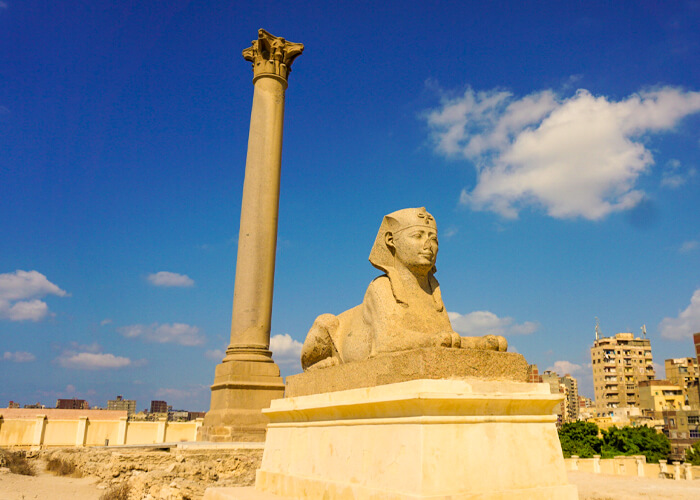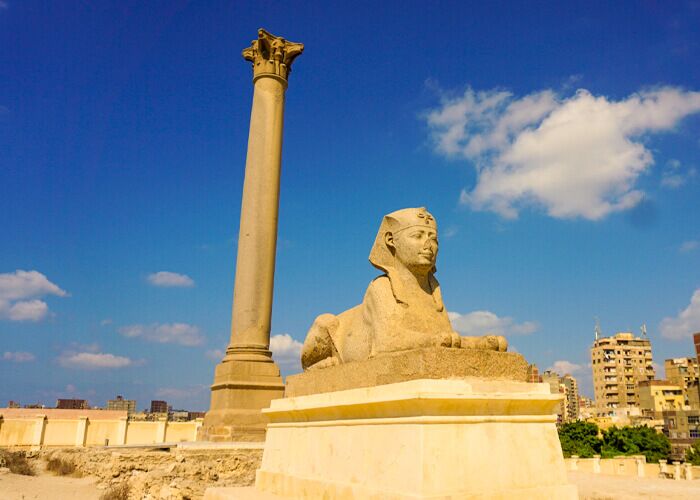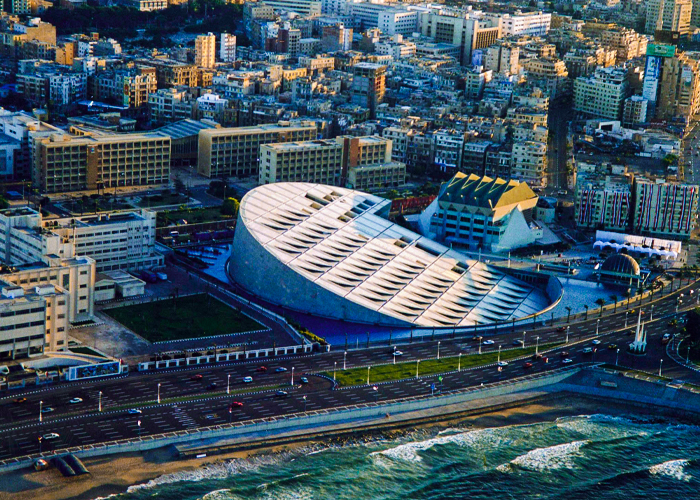Pompey’s Pillar: The Majestic Monument of Ancient Alexandria
Pompey’s Pillar in Alexandria, Egypt, is one of the most iconic and awe-inspiring ancient structures still standing in the city. Towering high above the surrounding landscape, this impressive column offers visitors a glimpse into Egypt’s rich history during the Roman era. It is often the first landmark that comes to mind when thinking about Alexandria’s ancient sites.
In this article, we’ll explore everything you need to know about Pompey’s Pillar Egypt, from its construction and significance to visiting tips and practical information for travelers. Whether you’re a history enthusiast or a first-time visitor to Alexandria, this guide will provide a comprehensive overview of the Pompey’s Pillar Alexandria Egypt, ensuring you can fully appreciate this ancient wonder.
The Origins and History of Pompey’s Pillar
Pompey’s Pillar Alexandria was constructed in honor of the Roman Emperor Diocletian around 297 CE. Contrary to what its name might suggest, it is not related to the Roman general Pompey, but rather a commemorative monument to the emperor’s victory over an uprising in Alexandria. It was originally built as part of a larger complex near the Serapeum, an ancient temple dedicated to the god Serapis.
The pillar of Pompey stands approximately 27 meters (89 feet) tall and is made of red Aswan granite. It was erected to celebrate Diocletian’s military achievements, but it also marks a key period in the history of Alexandria, a city that was a melting pot of cultures, philosophies, and religions during the Roman Empire.
The Egypt pillar served as a symbol of Roman power and control over Egypt, which had been a province of the Roman Empire since the 1st century BCE. The monument’s grandeur reflects the importance of Alexandria at the time, which was one of the largest cities in the Roman world, second only to Rome itself.

Architectural Features of Pompey’s Pillar
When visiting Pompey’s Pillar Alexandria, the first thing that strikes you is its monumental height and imposing presence. The Pompey’s Pillar is made entirely of red granite, a material that was brought from the famous quarries of Aswan, located far to the south. This durable stone was used extensively in ancient Egyptian and Roman architecture due to its strength and striking color.
The column itself is topped with a capital—a carved decoration at the top of the pillar—bearing a simple, yet elegant, design. The Pompey pillar is not just a solitary column but part of a larger, now lost, complex of temples and structures, which would have been visible from miles around. Its size and craftsmanship make it one of the most important surviving Roman monuments in Alexandria.
While the Pompey’s Pillar Egypt is awe-inspiring on its own, the site also provides visitors with breathtaking views of the surrounding area. Situated on a hill, the pillar commands a panoramic view of Alexandria, offering an excellent opportunity for photography and reflection.
The Mystery Behind the Name: Why is it Called Pompey’s Pillar?
Despite its name, Pompey’s Pillar Alexandria is not connected to the famous Roman general Pompey. The confusion surrounding its name likely stems from a mix-up in ancient times. Some historians believe that the name “Pompey” was used in reference to the monument’s association with the famous general’s defeat in Egypt, though there is no historical evidence that Pompey himself had any direct connection to the pillar.
The column was actually erected in honor of Emperor Diocletian, who played a significant role in quelling an uprising in Alexandria in the late 3rd century CE. The name “Pompey” was likely given to the pillar in later years, perhaps by locals who associated it with the events surrounding Pompey’s death in the city, or simply due to confusion with another Roman structure.
Regardless of its origins, the name “Pompey’s Pillar” has endured through the centuries, and it is still widely recognized as one of Alexandria’s most significant landmarks.
Pompey’s Pillar and the Serapeum: A Sacred Complex
The Pompey’s Pillar Alexandria Egypt once stood in a larger complex that included the Serapeum, a grand temple dedicated to the god Serapis, who was a fusion of the Egyptian gods Osiris and Apis. The Serapeum was one of the most important religious sites in Alexandria during the Roman period, and the Pompey pillar was located just outside its walls.
The Serapeum itself was renowned for its library, which rivaled the famous Library of Alexandria in its collection of scrolls and manuscripts. Unfortunately, the Serapeum, like much of ancient Alexandria, was destroyed in the 4th century CE, and much of its grandeur was lost to time. What remains of the Serapeum today is the site where the Pompey’s Pillar now stands.
Despite the loss of the Serapeum’s structures, the Pompeys pillar Alexandria serves as a poignant reminder of the city’s ancient religious and cultural importance. Standing beside the pillar, visitors can imagine what the complex must have looked like in its prime, with the towering column marking the entrance to one of Alexandria’s most revered religious sites.
Visiting Pompey’s Pillar: What to Expect
If you’re planning to visit Pompeys Pillar Egypt, there are several things you should know to make the most of your trip. Located near the center of Alexandria, the Pompeys pillar Alexandria is easily accessible by taxi or public transport.
When you arrive, you’ll notice the monumental column standing tall against the skyline. The Pompey’s Pillar Alexandria is set in a relatively quiet and scenic park-like area, which allows visitors to enjoy the site without the distractions of heavy crowds. The surrounding area is perfect for leisurely walks, and the view from the hilltop offers an excellent perspective of Alexandria’s coastal beauty.
At the base of the pillar, you’ll also find remnants of the ancient Serapeum, including large stone blocks and parts of the temple structure. While much of the original complex has been lost to time, these ruins provide a fascinating glimpse into Alexandria’s past and the architectural grandeur of the period.
Fun Facts About Pompey’s Pillar
-
Pompey’s Pillar Alexandria Egypt is the largest ancient Roman column in Egypt, standing at an impressive height of 27 meters (89 feet).
-
It is made from red granite, sourced from the quarries of Aswan, a city far to the south of Alexandria.
-
The column was erected in 297 CE by Emperor Diocletian to commemorate his victory over the Alexandrian revolt.
-
Despite its name, Pompey’s Pillar has no connection to the Roman general Pompey, as the monument was built long after his death.
-
The Pompey pillar originally stood in a complex that included the Serapeum, one of Alexandria’s most important religious sites.
-
The Pompey’s Pillar Egypt is one of the few surviving structures from Alexandria’s Roman period and offers visitors an invaluable insight into the city’s rich history.
Best Time to Visit Pompey’s Pillar
For travelers planning to visit Pompeys Pillar Alexandria, timing your visit can make a big difference in your experience. The best time to visit is during the cooler months, from October to April, when the weather is more comfortable for walking and exploring. Alexandria’s Mediterranean climate is mild, but the summer months can get quite hot, with temperatures reaching over 30°C (86°F).
Arriving early in the morning or later in the afternoon will help you avoid the peak crowds and provide the best lighting for photos. This also gives you a chance to enjoy the monument’s peaceful surroundings without the hustle and bustle of the city.
Nearby Attractions to Explore After Visiting Pompey’s Pillar
While Pompey’s Pillar Alexandria is a major highlight in Alexandria, the city is also home to several other fascinating historical sites worth exploring. After visiting the pillar, consider checking out:
-
The Library of Alexandria: A modern architectural marvel and cultural center built to honor the ancient Library of Alexandria.
-
The Catacombs of Kom el Shoqafa: A stunning underground burial site that combines Egyptian, Greek, and Roman styles of architecture.
-
The Citadel of Qaitbay: A 15th-century fortress built on the site of the ancient Pharos Lighthouse, one of the Seven Wonders of the Ancient World.
-
Pompey’s Pillar is just one stop on your journey through Alexandria’s rich history, and the surrounding sites are sure to captivate your imagination and deepen your appreciation for Egypt’s ancient past.
Final Thoughts: Why Pompey’s Pillar Should Be on Your List
Pompey’s Pillar Alexandria is not just an impressive monument; it’s a testament to Alexandria’s strategic importance during the Roman era and a remarkable piece of history that continues to stand tall to this day. Whether you’re an avid history lover or simply looking to explore one of Egypt’s most iconic landmarks, this ancient pillar offers a captivating journey through time.
With its striking appearance, historical significance, and stunning views, Pompey’s Pillar Egypt is a must-visit destination for anyone traveling to Alexandria. Don’t miss the opportunity to witness this monumental piece of history on your next Egyptian adventure.


